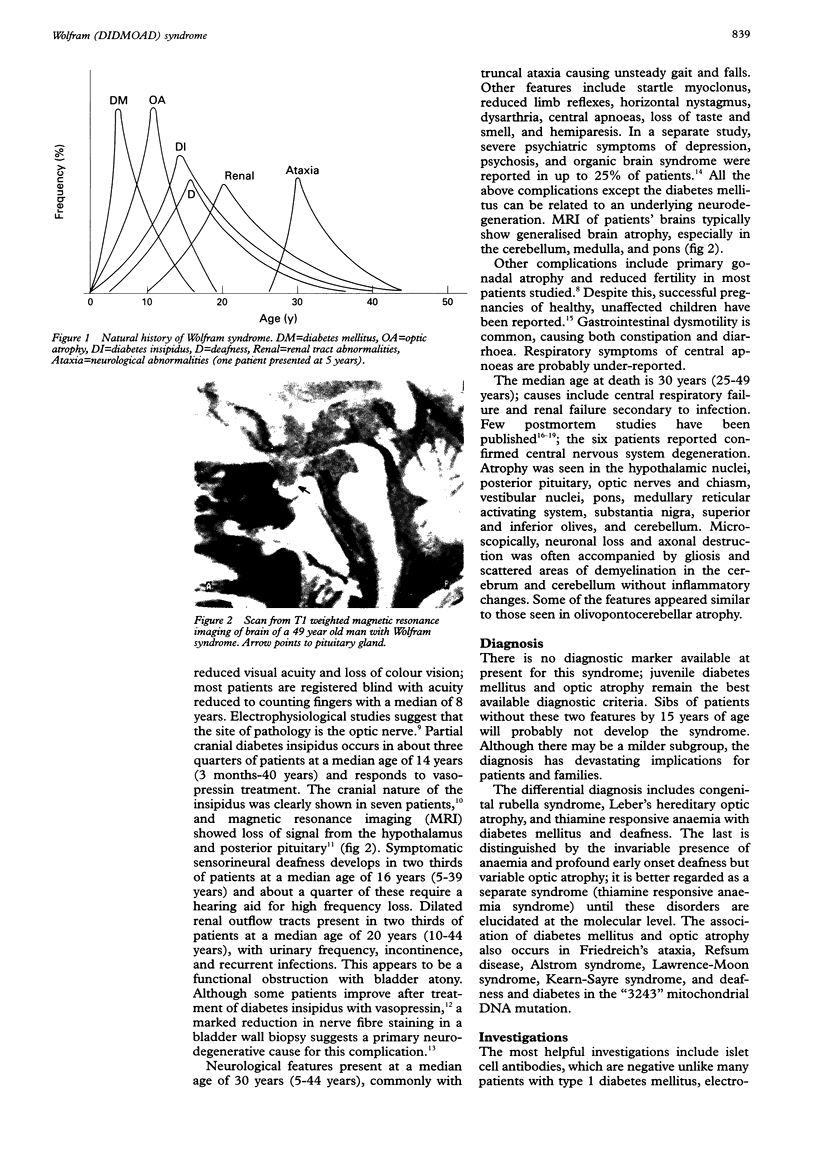Abstract
Wolfram syndrome (MIM 222300) is the association of juvenile onset diabetes mellitus and optic atrophy, also known as DIDMOAD (Diabetes Insipidus, Diabetes Mellitus, Optic Atrophy, and Deafness). Patients present with diabetes mellitus followed by optic atrophy in the first decade, cranial diabetes insipidus and sensorineural deafness in the second decade, dilated renal outflow tracts early in the third decade, and multiple neurological abnormalities early in the fourth decade. Other abnormalities include primary gonadal atrophy. Death occurs prematurely, often from respiratory failure associated with brainstem atrophy. Most patients eventually develop all complications of this progressive, neurodegenerative disorder. The pathogenesis is unknown, but the prevalence is 1 in 770000 in the UK and inheritance is autosomal recessive. A Wolfram gene has recently been mapped to chromosome 4p16.1, but there is evidence for locus heterogeneity, and it is still possible that a minority of patients may harbour a mitochondrial genome deletion. The best available diagnostic criteria are juvenile onset diabetes mellitus and optic atrophy, but there is a wide differential diagnosis which includes other causes of neurodegeneration.
Full text
PDF



Images in this article
Selected References
These references are in PubMed. This may not be the complete list of references from this article.
- Barrett T. G., Bundey S. E., Macleod A. F. Neurodegeneration and diabetes: UK nationwide study of Wolfram (DIDMOAD) syndrome. Lancet. 1995 Dec 2;346(8988):1458–1463. doi: 10.1016/s0140-6736(95)92473-6. [DOI] [PubMed] [Google Scholar]
- Barrett T. G., Poulton K., Bundey S. DIDMOAD syndrome; further studies and muscle biochemistry. J Inherit Metab Dis. 1995;18(2):218–220. doi: 10.1007/BF00711771. [DOI] [PubMed] [Google Scholar]
- Barrientos A., Casademont J., Saiz A., Cardellach F., Volpini V., Solans A., Tolosa E., Urbano-Marquez A., Estivill X., Nunes V. Autosomal recessive Wolfram syndrome associated with an 8.5-kb mtDNA single deletion. Am J Hum Genet. 1996 May;58(5):963–970. [PMC free article] [PubMed] [Google Scholar]
- Blasi C., Pierelli F., Rispoli E., Saponara M., Vingolo E., Andreani D. Wolfram's syndrome: a clinical, diagnostic, and interpretative contribution. Diabetes Care. 1986 Sep-Oct;9(5):521–528. doi: 10.2337/diacare.9.5.521. [DOI] [PubMed] [Google Scholar]
- Bundey S., Poulton K., Whitwell H., Curtis E., Brown I. A., Fielder A. R. Mitochondrial abnormalities in the DIDMOAD syndrome. J Inherit Metab Dis. 1992;15(3):315–319. doi: 10.1007/BF02435965. [DOI] [PubMed] [Google Scholar]
- COOPER I. S., RYNEARSON E. H., BAILEY A. A., MacCARTY C. S. The relation of spinal cord diseases to gynecomastia and testicular atrophy. Proc Staff Meet Mayo Clin. 1950 Jun 7;25(12):320–326. [PubMed] [Google Scholar]
- Carson M. J., Slager U. T., Steinberg R. M. Simultaneous occurrence of diabetes mellitus, diabetes insipidus, and optic atrophy in a brother and sister. Am J Dis Child. 1977 Dec;131(12):1382–1385. doi: 10.1001/archpedi.1977.02120250064010. [DOI] [PubMed] [Google Scholar]
- Chu P., Staff W. G., Morris J. A., Polak J. M. DIDMOAD syndrome with megacystis and megaureter. Postgrad Med J. 1986 Sep;62(731):859–863. doi: 10.1136/pgmj.62.731.859. [DOI] [PMC free article] [PubMed] [Google Scholar]
- Collier D. A., Barrett T. G., Curtis D., Macleod A., Arranz M. J., Maassen J. A., Bundey S. Linkage of Wolfram syndrome to chromosome 4p16.1 and evidence for heterogeneity. Am J Hum Genet. 1996 Oct;59(4):855–863. [PMC free article] [PubMed] [Google Scholar]
- Davidson I. R., McNicholl J. M., O'Donnell J. Successful pregnancy in two sisters with Wolfram syndrome. Ir Med J. 1993 Jan;86(1):33–34. [PubMed] [Google Scholar]
- Fraser F. C., Gunn T. Diabetes mellitus, diabetes insipidus, and optic atrophy. An autosomal recessive syndrome? J Med Genet. 1977 Jun;14(3):190–193. doi: 10.1136/jmg.14.3.190. [DOI] [PMC free article] [PubMed] [Google Scholar]
- Gunn T., Bortolussi R., Little J. M., Andermann F., Fraser F. C., Belmonte M. M. Juvenile diabetes mellitus, optic atrophy, sensory nerve deafness, and diabetes insipidus--a syndrome. J Pediatr. 1976 Oct;89(4):565–570. doi: 10.1016/s0022-3476(76)80387-3. [DOI] [PubMed] [Google Scholar]
- Karp M., Laron Z., Sanbank U. Wolfram syndrome. Am J Dis Child. 1978 Aug;132(8):818–819. doi: 10.1001/archpedi.1978.02120330090023. [DOI] [PubMed] [Google Scholar]
- Mtanda A. T., Cruysberg J. R., Pinckers A. J. Optic atrophy in Wolfram syndrome. Ophthalmic Paediatr Genet. 1986 Dec;7(3):159–165. doi: 10.3109/13816818609004133. [DOI] [PubMed] [Google Scholar]
- PALEY R. G., TUNBRIDGE R. E. Primary optic atrophy in diabetes mellitus. Diabetes. 1956 Jul-Aug;5(4):295–296. doi: 10.2337/diab.5.4.295. [DOI] [PubMed] [Google Scholar]
- Page M. M., Asmal A. C., Edwards C. R. Recessive inheritance of diabetes: the syndrome of diabetes insipidus, diabetes mellitus, optic atrophy and deafness. Q J Med. 1976 Jul;45(179):505–520. [PubMed] [Google Scholar]
- Polymeropoulos M. H., Swift R. G., Swift M. Linkage of the gene for Wolfram syndrome to markers on the short arm of chromosome 4. Nat Genet. 1994 Sep;8(1):95–97. doi: 10.1038/ng0994-95. [DOI] [PubMed] [Google Scholar]
- Rando T. A., Horton J. C., Layzer R. B. Wolfram syndrome: evidence of a diffuse neurodegenerative disease by magnetic resonance imaging. Neurology. 1992 Jun;42(6):1220–1224. doi: 10.1212/wnl.42.6.1220. [DOI] [PubMed] [Google Scholar]
- Swift R. G., Sadler D. B., Swift M. Psychiatric findings in Wolfram syndrome homozygotes. Lancet. 1990 Sep 15;336(8716):667–669. doi: 10.1016/0140-6736(90)92157-d. [DOI] [PubMed] [Google Scholar]
- Thompson C. J., Charlton J., Walford S., Baird J., Hearnshaw J., McCulloch A., Kelly W., Baylis P. H. Vasopressin secretion in the DIDMOAD (Wolfram) syndrome. Q J Med. 1989 Apr;71(264):333–345. [PubMed] [Google Scholar]



